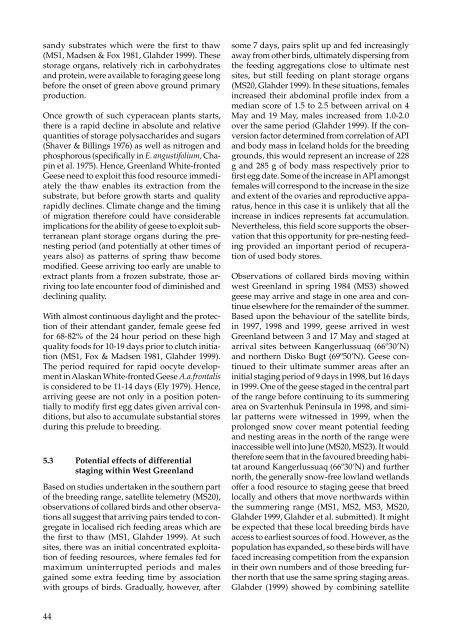The Greenland White-fronted Goose Anser albifrons flavirostris
The Greenland White-fronted Goose Anser albifrons flavirostris
The Greenland White-fronted Goose Anser albifrons flavirostris
Create successful ePaper yourself
Turn your PDF publications into a flip-book with our unique Google optimized e-Paper software.
sandy substrates which were the first to thaw<br />
(MS1, Madsen & Fox 1981, Glahder 1999). <strong>The</strong>se<br />
storage organs, relatively rich in carbohydrates<br />
and protein, were available to foraging geese long<br />
before the onset of green above ground primary<br />
production.<br />
Once growth of such cyperacean plants starts,<br />
there is a rapid decline in absolute and relative<br />
quantities of storage polysaccharides and sugars<br />
(Shaver & Billings 1976) as well as nitrogen and<br />
phosphorous (specifically in E. angustifolium, Chapin<br />
et al. 1975). Hence, <strong>Greenland</strong> <strong>White</strong>-<strong>fronted</strong><br />
Geese need to exploit this food resource immediately<br />
the thaw enables its extraction from the<br />
substrate, but before growth starts and quality<br />
rapidly declines. Climate change and the timing<br />
of migration therefore could have considerable<br />
implications for the ability of geese to exploit subterranean<br />
plant storage organs during the prenesting<br />
period (and potentially at other times of<br />
years also) as patterns of spring thaw become<br />
modified. Geese arriving too early are unable to<br />
extract plants from a frozen substrate, those arriving<br />
too late encounter food of diminished and<br />
declining quality.<br />
With almost continuous daylight and the protection<br />
of their attendant gander, female geese fed<br />
for 68-82% of the 24 hour period on these high<br />
quality foods for 10-19 days prior to clutch initiation<br />
(MS1, Fox & Madsen 1981, Glahder 1999).<br />
<strong>The</strong> period required for rapid oocyte development<br />
in Alaskan <strong>White</strong>-<strong>fronted</strong> Geese A.a.frontalis<br />
is considered to be 11-14 days (Ely 1979). Hence,<br />
arriving geese are not only in a position potentially<br />
to modify first egg dates given arrival conditions,<br />
but also to accumulate substantial stores<br />
during this prelude to breeding.<br />
5.3 Potential effects of differential<br />
staging within West <strong>Greenland</strong><br />
Based on studies undertaken in the southern part<br />
of the breeding range, satellite telemetry (MS20),<br />
observations of collared birds and other observations<br />
all suggest that arriving pairs tended to congregate<br />
in localised rich feeding areas which are<br />
the first to thaw (MS1, Glahder 1999). At such<br />
sites, there was an initial concentrated exploitation<br />
of feeding resources, where females fed for<br />
maximum uninterrupted periods and males<br />
gained some extra feeding time by association<br />
with groups of birds. Gradually, however, after<br />
44<br />
some 7 days, pairs split up and fed increasingly<br />
away from other birds, ultimately dispersing from<br />
the feeding aggregations close to ultimate nest<br />
sites, but still feeding on plant storage organs<br />
(MS20, Glahder 1999). In these situations, females<br />
increased their abdominal profile index from a<br />
median score of 1.5 to 2.5 between arrival on 4<br />
May and 19 May, males increased from 1.0-2.0<br />
over the same period (Glahder 1999). If the conversion<br />
factor determined from correlation of API<br />
and body mass in Iceland holds for the breeding<br />
grounds, this would represent an increase of 228<br />
g and 285 g of body mass respectively prior to<br />
first egg date. Some of the increase in API amongst<br />
females will correspond to the increase in the size<br />
and extent of the ovaries and reproductive apparatus,<br />
hence in this case it is unlikely that all the<br />
increase in indices represents fat accumulation.<br />
Nevertheless, this field score supports the observation<br />
that this opportunity for pre-nesting feeding<br />
provided an important period of recuperation<br />
of used body stores.<br />
Observations of collared birds moving within<br />
west <strong>Greenland</strong> in spring 1984 (MS3) showed<br />
geese may arrive and stage in one area and continue<br />
elsewhere for the remainder of the summer.<br />
Based upon the behaviour of the satellite birds,<br />
in 1997, 1998 and 1999, geese arrived in west<br />
<strong>Greenland</strong> between 3 and 17 May and staged at<br />
arrival sites between Kangerlussuaq (66º30’N)<br />
and northern Disko Bugt (69º50’N). Geese continued<br />
to their ultimate summer areas after an<br />
initial staging period of 9 days in 1998, but 16 days<br />
in 1999. One of the geese staged in the central part<br />
of the range before continuing to its summering<br />
area on Svartenhuk Peninsula in 1998, and similar<br />
patterns were witnessed in 1999, when the<br />
prolonged snow cover meant potential feeding<br />
and nesting areas in the north of the range were<br />
inaccessible well into June (MS20, MS23). It would<br />
therefore seem that in the favoured breeding habitat<br />
around Kangerlussuaq (66º30’N) and further<br />
north, the generally snow-free lowland wetlands<br />
offer a food resource to staging geese that breed<br />
locally and others that move northwards within<br />
the summering range (MS1, MS2, MS3, MS20,<br />
Glahder 1999, Glahder et al. submitted). It might<br />
be expected that these local breeding birds have<br />
access to earliest sources of food. However, as the<br />
population has expanded, so these birds will have<br />
faced increasing competition from the expansion<br />
in their own numbers and of those breeding further<br />
north that use the same spring staging areas.<br />
Glahder (1999) showed by combining satellite


